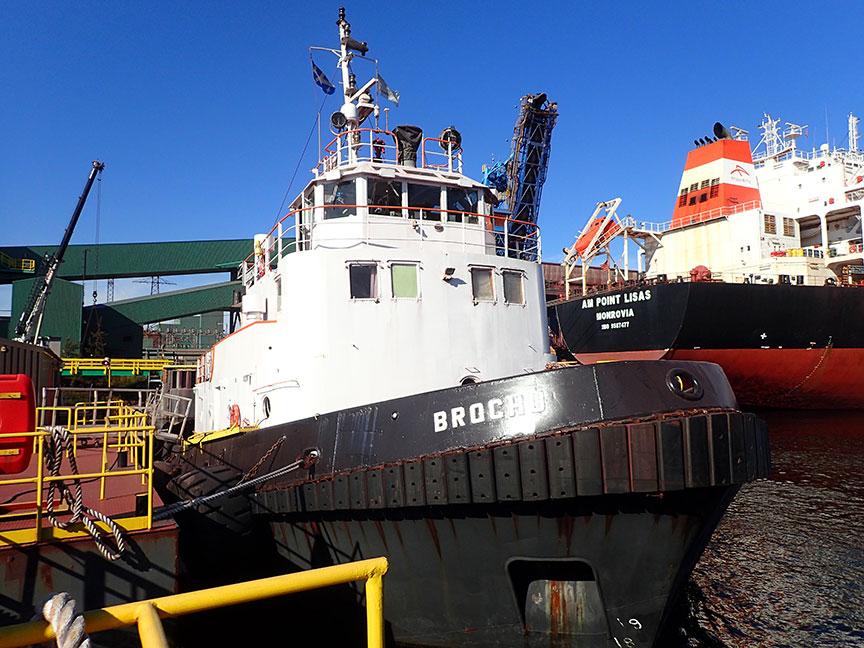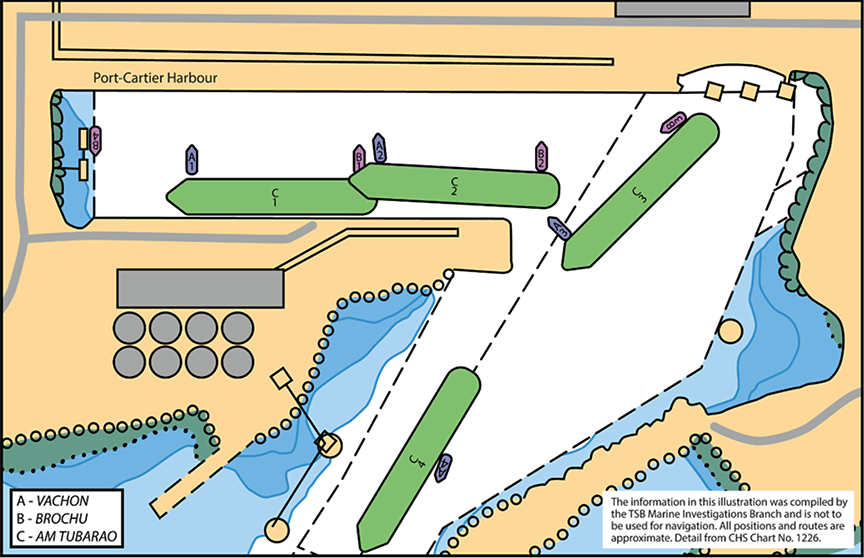Mechanical failure and subsequent fire
Tug Brochu
Port-Cartier, Quebec
The Transportation Safety Board of Canada (TSB) investigated this occurrence for the purpose of advancing transportation safety. It is not the function of the Board to assign fault or determine civil or criminal liability. This report is not created for use in the context of legal, disciplinary or other proceedings. See Ownership and use of content. Masculine pronouns and position titles may be used to signify all genders to comply with the Canadian Transportation Accident Investigation and Safety Board Act (S.C. 1989, c. 3).
Vessel description
The BrochuFootnote 1 is a steel-hulled harbour tug that is 30.45 m in length with a gross tonnage of 389.68 (Figure 1). The tug's superstructure and machinery spaces are located amidships. The tug has 2 conning positions: 1 on the port side and 1 on the starboard side. The navigation equipment consists of 2 very high frequency (VHF) radiotelephones, an echo sounder, an electronic chart display, a radar, and a global positioning system. The tug has a maximum bollard pull of 35 tonnes.
The Brochu is equipped with 2 main engines; each engine drives a cycloidal propeller that is coupled by a hydrodynamic fluid coupling. The maximum continuous operating temperature of the couplings is not to exceed 85–90 °C.Footnote 2 Each fluid coupling is equipped with a thermal control element that triggers an aural and visual alarm to alert the operator when the coupling reaches 125 °C.Footnote 3 When this occurs, the drive must be shut down immediately so that the turbo-coupling temperature will not continue to rise. Each fluid coupling is also equipped with 3 fusible plugs that melt when the coupling reaches 140 °CFootnote 4 ; this allows the oil to drain, which stops all power transmission and thus prevents excessive pressure build-up inside the coupling.
History of the voyage
On 15 September 2017, at 0200,Footnote 5 the bulk carrier AM Tubarao finished loading its cargo (77 565 tonnes of iron ore pellets and 9938 tonnes of iron ore concentrate) at Port-Cartier's dock No. 2. A pilot and 2 tugs—the Vachon and the Brochu—were then tasked with assisting the bulk carrier out of the harbour.
At 0330, the engineer on watch started each tug's engines to warm them up. At 0400, the pilot boarded the AM Tubarao. The Vachon was positioned forward of the bulk carrier and its towing cable was attached to the bulk carrier's bow. The Brochu was positioned aft, and its towing cable was attached to the bulk carrier's stern.
The plan was for the tugs to manoeuvre the bulk carrier out of the harbour by pulling the bulk carrier away from the dock, then pulling it astern while its engine was astern to enable the bow to pass the dock corner. After the bow was clear of the corner, the Vachon would position the bow of the bulk carrier toward the centre of the harbour channel, and both tugs would guide the bulk carrier into the channel. Once the bulk carrier was clear of the channel, the tugs would retrieve their towing lines, pick up the pilot, and return to their berth (see Figure 2 for a depiction of manoeuvre B4).
At 0419, the AM Tubarao's mooring lines were cast off and the pilot ordered the tugs to pull at different power levels (between 0% and 80% power, as needed) in order to help the bulk carrier move away and maintain a safe distance from the dock (see Figure 2, manoeuvre C2).
A short time later, the pilot on the AM Tubarao noticed that the stern of the bulk carrier had stopped moving. At approximately 0427, at the pilot's request and as per standard procedure, the master of the Brochu removed the lock on the tug's propulsion control lever, and the tug pulled on the bulk carrier at maximum power (power level 10).
Shortly after 0433, the Brochu's starboard fluid coupling's visual and aural high-temperature alarm (which was located in the wheelhouse) activated, indicating that the coupling oil had reached 125 °C. The bridge teams were not aware of the significance of this alarm. The Brochu continued to pull at maximum power, causing the internal temperature of the starboard fluid coupling to increase further.
At approximatively 0434, the Brochu's starboard fluid coupling oil reached 140 °C and the 3 fusible plugs melted. Once the plugs melted, the hot oil released into the tug's machinery space. With no oil in the coupling, the starboard cycloidal propeller disengaged and the overspeed protection system shut the engine down.
The hot oil vaporized and ignited, either when it made contact with a hot surface such as the engine exhaust manifold, or owing to a spark that may have come from the nearby generator.
At 0436, the master of the Vachon called the master of the Brochu on the VHF radiotelephone to inform him that fire could be seen coming out of the Brochu's funnel. The master of the Vachon also called the owner's marine agency so that the agency could notify the municipal and company fire departments and call in a replacement tug.
The pilot on the AM Tubarao then called the master of the Brochu to discuss the situation. While speaking with the pilot, the master detected smoke in the Brochu's wheelhouse. The master then reduced power to the port main engine and ordered the engineer to assess the situation in the engine room. Seeing the fire through the engine room door's porthole, and seeing smoke enter the tug accommodation area from around the door, the engineer did not enter the engine room.
Smoke began to fill the wheelhouse, and the master opened the wheelhouse external doors in order to ventilate the space. The master ordered the engineer to wait to release carbon dioxide in the engine room, as the port main engine was needed to detach the tug's towing cable from the bulk carrier. Around 0443, the Brochu disconnected its towing cable from the bulk carrier and returned to its berth.
Emergency response
By 0445, the Brochu had returned to its berth, and the crew had activated the fuel shutoff valves, which shut down the remaining port main engine and generator, and closed the engine room ventilation dampers. The crew searched the engine room's external bulkhead for hot spots but did not find any.
At approximately 0540, the company's fire department entered the tug engine room and, with the help of a thermographic camera, determined that the fire had not spread beyond the engine room and was extinguished.
Post-occurrence examination
Turbo coupling
A post-occurrence examination of the Brochu determined that the starboard fluid coupling's thermal control element had activated, triggering the alarm in the wheelhouse. The examination also showed that the 3 fusible plugs had melted. The thermal control element and thermal plugs were found to have worked within their design parameters. Hydraulic fluid samples were extracted from the port and starboard fluid couplings for testing. The oil sample from the starboard coupling contained significantly more metallic particles than did the sample from the port coupling; some of the particles were relatively large. This may indicate abnormal wear or internal damage to the coupling.
Gastightness of the engine room
In Canada, regulations specify that gastight bulkheads must be fitted so as to separate every part of the crew accommodation from a space used as a machinery space.Footnote 6 As well, every crew access opening, if it provides access from an accommodation space to the engine room, must be gastight.Footnote 7
In this occurrence, smoke leaked from the engine room into the crew accommodation area. Soot was observed around a ventilation grid mounted on the engine room bulkhead, indicating that a ventilation duct from the engine room allowed the smoke to reach the crew accommodation space.
The Brochu's propulsion control trunk is equipped with gastight glands around the propulsion control rods, and has a cover screwed in place, as well as gaskets. The gastight glands were not maintained in working condition, and the cover gasket and most of the screws were missing, allowing smoke to enter the wheelhouse.
Environmental conditions
At the time of the occurrence, visibility was good. It was a clear night, with northeast winds of 3 knots and a calm sea.
Safety messages
The investigation revealed the following unsafe conditions on board the Brochu that affected the crew's health and safety and the tug's machinery operation, rendering it vulnerable to extensive damage in case of a coupling malfunction:
- The engine was kept at maximum power after the high-temperature coupling alarm sounded.
- Crew members were not aware of the significance of the alarm, nor were they provided with specific training on what to do in such cases.
- The operational temperature of the coupling, i.e. the principal indication of the coupling's condition, was not monitored by a continuous temperature monitoring system or manually.
- The machinery compartment's gastight devices were not maintained in accordance with regulations, causing smoke to enter the wheelhouse and crew accommodation.
Safety action
On 14 December 2017, the TSB issued Marine Safety Advisory Letter No. 04/17, Overheating of hydrodynamic fluid coupling and subsequent fire, and on 05 March 2018, the TSB issued Marine Safety Advisory Letter No. 01/18, Tug engine room bulkhead and closing appliance not gastight, to Transport Canada and other stakeholders, to inform them of the unsafe conditions of the occurrence.
Following the occurrence, Transport Canada issued FLAGSTATENET 03-2018: Watertight and Gastight Integrity, advising inspectors and surveyors to closely observe fittings intended to make accommodation spaces and the wheelhouse gastight, as well as openings in watertight decks and bulkheads, during inspections.
This concludes the TSB's limited-scope investigation into this occurrence. The Board authorized the release of this investigation brief on . It was officially released on .

